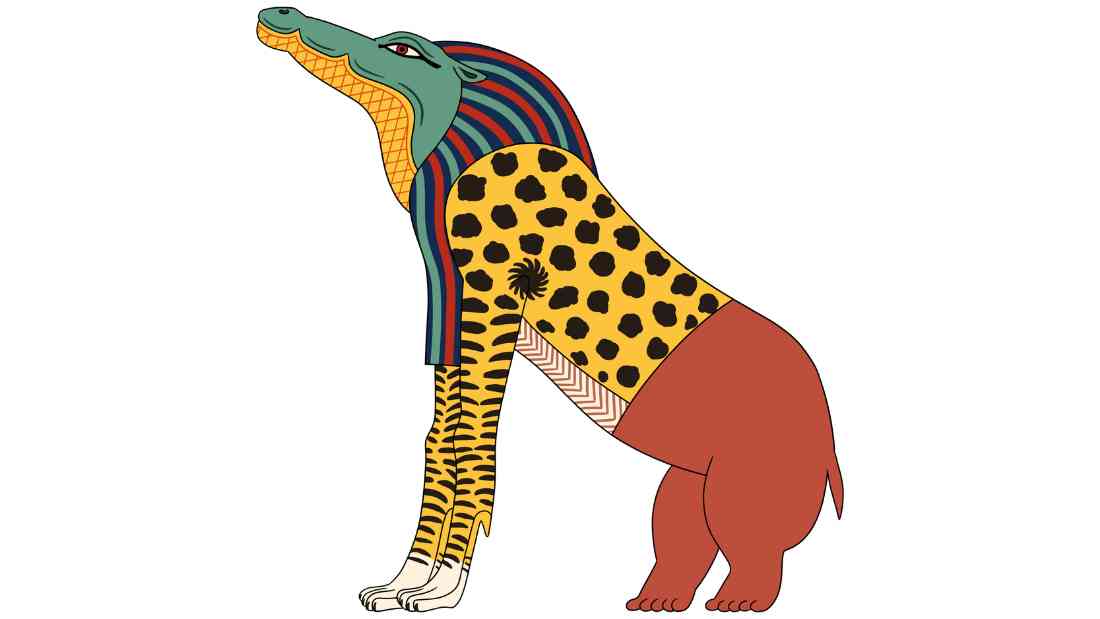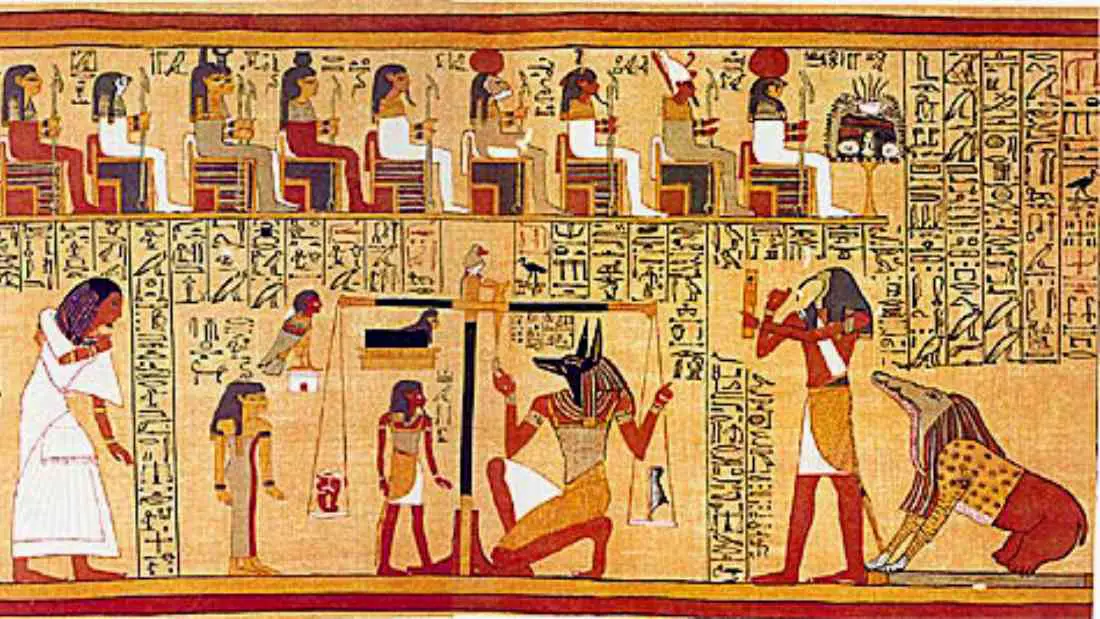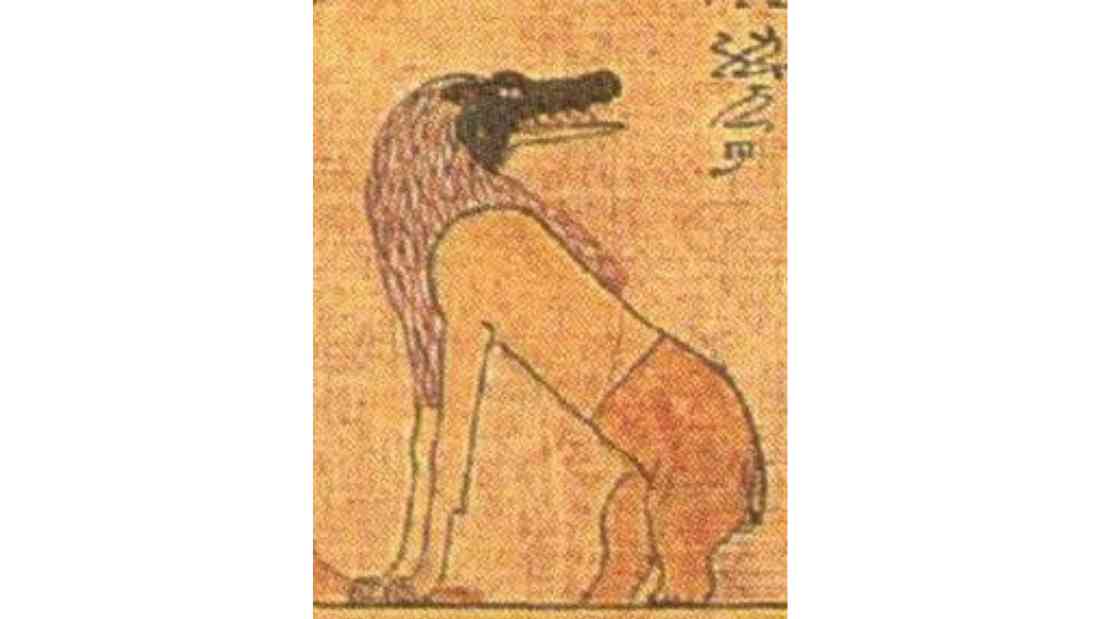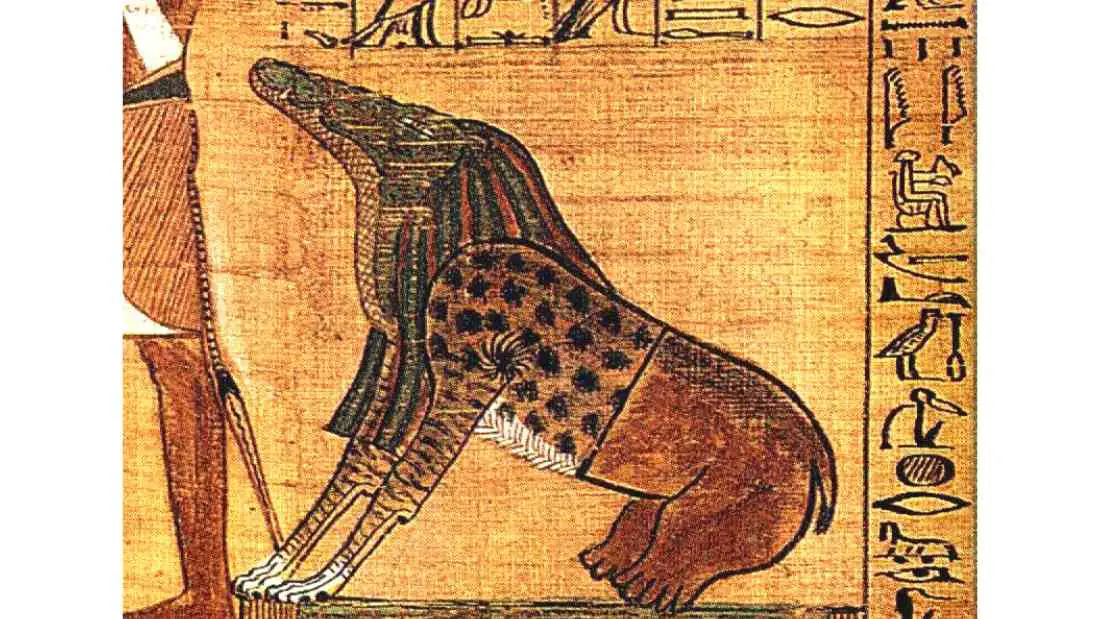In the pantheon of ancient Egypt, few are as intriguing or fearsome as the Egyptian god Ammit, the Devourer of Hearts. A unique fusion of three deadly creatures – the lion, the hippopotamus, and the crocodile – Ammit held a central role in the afterlife beliefs of the ancient Egyptians.

Ammit – The Egyptian God Who Devoured the Unworthy
Ammit, a deity in ancient Egyptian religion, had a unique niche within the pantheon of gods. Unlike traditional gods and goddesses who were worshipped in hopes of divine favor, Ammit was a deity to be dreaded.
She wasn’t a god of fertility, love, war, or any other element of life. Instead, she held dominion over the fate of souls in the afterlife. Her very presence was a grim reminder of the consequences of leading an unjust life.
Her name, which translates to “Devourer of the Dead” or “Eater of Hearts,” offers a glimpse into her formidable role in the afterlife beliefs of the Egyptians.
The Hall of Ma’at and the Role of the Egyptian God Ammit
Ancient Egyptian mythology is a rich tapestry of gods, goddesses, and celestial ceremonies. Among these, the Hall of Ma’at stands out as a pivotal realm where the deceased faced their final judgment.
The Hall of Ma’at, named after the goddess of truth, balance, order, and justice, was a sacred space of reckoning. Here, the hearts of the departed were brought forth for an ultimate evaluation of their earthly deeds.
This hall served as the celestial courtroom where the fate of every soul was decided.
Ammit’s Crucial Role in the ‘Weighing of the Heart’ Ceremony
Ammit held a crucial position in the ‘Weighing of the Heart’ ceremony, a pivotal stage in the journey of the soul in the afterlife.
This ceremony wasn’t just a ritual but a test of moral integrity and virtue that determined the soul’s eternal destiny.
In this ceremony, the heart, considered the seat of the soul and emotions, was set on one side of a scale. On the other side rested the feather of Ma’at, a symbol of truth and righteousness.
This balance represented the moral equilibrium between right and wrong.
If the scales found equality, it signified that the individual had led a virtuous life. Their soul would then be granted passage to the Field of Reeds, the ancient Egyptian equivalent of paradise, an eternal realm of peace and abundance.
However, if the heart outweighed the feather, it was a damning indictment of a life steeped in sin and moral corruption. The soul would then face the terrifying retribution of Ammit.
The Egyptian God Ammit – The Ultimate Punisher
Ammit, ever-watchful by the scales, would devour the hearts deemed unworthy due to the weight of their sins. This act was more than physical consumption. It symbolized the complete eradication of the soul.
The ancient Egyptians believed in the concept of ‘second death,’ a state where the soul ceased to exist entirely, a fate deemed far worse than physical death.
In embodying this ultimate punishment, Ammit represented the finality of judgment and the absolute end of existence for those deemed sinful.

The Unique Appearance of Ammit
Ammit, the Devourer of Souls, had a distinctive appearance.
Unlike many other deities depicted in humanoid forms or as sacred animals, Ammit was an amalgamation of three of Egypt’s most dangerous creatures, each component contributing to her terrifying persona.
Crocodile-Headed Symbol of Aggression
The head of Ammit was that of a crocodile, one of the apex predators of the Nile.
This choice was far from random. In ancient Egyptian symbolism, the crocodile represented assertiveness, aggression, and raw power.
Its reputation as a merciless hunter made it the perfect embodiment for Ammit’s unforgiving nature.
Lion’s Torso – A Sign of Power and Ferocity
The middle part of Ammit, her torso, was that of a lion, another top predator revered for its courage, power, and ferocity.
The lion’s strength and dominance over other animals mirrored Ammit’s authority in the Hall of Ma’at.
Just like a lion, she was an unchallengeable force, embodying the relentless pursuit of justice.
Hippopotamus – The Symbol of Fertility and Rebirth
Contrasting with the aggressive symbols of the crocodile and lion, the lower body and backside of Ammit were that of a hippopotamus, a creature associated with feminine fertility and rebirth in ancient Egyptian symbolism.
This juxtaposition added a layer of complexity to Ammit’s character. While she was a symbol of terror and retribution, the hippo element hinted at a form of regeneration or renewal following judgment, reminding that her role was not just about punishment, but also about maintaining the cosmic balance.
The depiction of Ammit is thus a masterful blend of symbolism and fear.
Her composite form – crocodile, lion, and hippopotamus – each contributes to the understanding of her character and role.
She was not merely a figure of terror but a representation of divine justice, a testament to the belief that actions carry consequences.

Ammit as a Moral Deterrent
Ammit’s role transcended the metaphysical realm of the afterlife and had profound implications on the living. She served as a potent deterrent, symbolizing divine retribution for those who deviated from the path of righteousness
Her terrifying image and fearsome reputation served as a constant reminder of the potential consequences of immoral actions.
This fear of divine punishment acted as a powerful deterrent, influencing individuals to adhere to moral and ethical norms in their daily lives.
Symbolizing Divine Retribution
In her capacity as the devourer of sinful hearts, Ammit became a potent symbol of divine retribution.
The ancient Egyptians deeply believed in Ma’at’s principles of truth, balance, and justice. Any deviation from these principles was seen as a disruption of the cosmic order, warranting divine punishment.
Ammit personified this punishment, devouring the hearts of those deemed unworthy in the Hall of Ma’at.
Reinforcing Virtue, Justice, and Balance
While her role might seem fearsome, it’s crucial to understand that Ammit was not a malevolent entity.
Instead, she was a necessary aspect of the cosmic order, embodying the consequences of immoral actions. By doing so, she underscored the importance of virtue, justice, and balance in daily life.
Through her existence and the fear she inspired, Ammit encouraged adherence to Ma’at’s principles, promoting a harmonious society where every individual was accountable for their actions.
Therefore, Ammit’s role was not just about enforcing divine retribution but also fostering an environment of morality and righteousness.
Final Thoughts about the Egyptian God Ammit
Ammit, in her fearsome grandeur, played a pivotal role in ancient Egyptian religion and society.
As a symbol of divine retribution, she served as a powerful reminder of the consequences of straying from righteousness.
Her presence reinforced the importance of ethical conduct, justice, and balance, contributing significantly to the moral fabric of ancient Egyptian culture.

Frequently Asked Questions About The Egyptian God Ammit
Ammit, also known as the “Devourer of the Dead,” is a deity in ancient Egyptian mythology who played a crucial role in the afterlife. She was not worshipped but was revered for her function as a divine enforcer of Ma’at’s principles of truth and balance.
In the Hall of Ma’at, Ammit had a pivotal role in the ‘Weighing of the Heart’ ceremony. If the deceased’s heart, weighed against the feather of Ma’at, was found heavier due to sinful actions, Ammit would devour the heart, leading to a ‘second death’ where the soul ceased to exist.
Ammit had a unique and terrifying appearance, combining features of three of Egypt’s most dangerous animals. She had the head of a crocodile, the torso of a lion, and the lower body and backside of a hippopotamus.
Ammit was not considered evil. Instead, she was seen as a necessary force in maintaining cosmic balance. She symbolized divine retribution and served as a deterrent for immoral behavior, reinforcing the importance of virtue, justice, and balance.
Posts About the Egyptian Pantheon of Gods
The Pantheon of Ancient Egyptian Gods – A Comprehensive Guide
The Wrath of Montu – The Mythology of the Egyptian War God
Egyptian God Ammit – The Eater of Hearts in Ancient Egyptian Mythology
The Nightly Journey of Khonsu – The Ancient Egyptian God of the Moon
Ihy – The Joyful Ancient Egyptian God of Music
Min – The Ancient Egyptian God of Fertility
The Egyptian God Anubis – His Evolution from Son of Ra to Protector of the Dead
Unraveling the Mysteries of Babi – The Ancient Egyptian Baboon God
Ra, the Egyptian Sun God – Symbolism and Significance in Ancient Egyptian Culture
Sobek: The Ferocious Crocodile God of Ancient Egypt
The Enigmatic Mythology of Horus, the Egyptian Sky God
The Egyptian God Set – Protector of the Desert and Lord of Conflict
The Ancient Egyptian God Medjed: The Guardian of Osiris and the Afterlife
Anput, the Wife and Female Version of Anubis
Selket – The Scorpion Crowned Egyptian Goddess
Shu – The Egyptian God of Air, Wind, Peace and Lions
Hapi the Androgynous Ancient Egyptian God of the Nile
The Egyptian Sky Goddess Nut: Myth and Symbolism
The 42 Laws of Maat: The Moral Principles of the Ancient Egyptians
The Ancient Egyptian Goddess Mut: The Maternal Power in Egyptian Mythology
The Warrior Goddess: Neith in Ancient Egyptian Mythology
The God Bes: The Joyful Dwarf Deity in Ancient Egyptian Culture
The Egyptian Gods of Love: Hathor and Isis in Ancient Egyptian Mythology
Confronting the Serpent: The God Apep, the Nemesis of Ra in Egyptian Myth

